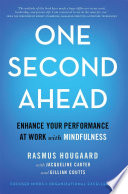

The book delves into how technology can be leveraged to enhance anticipation. With the advent of data analytics, artificial intelligence, and machine learning, organizations can analyze trends and patterns to predict future behaviors. The author discusses various technological tools that can help individuals and businesses stay one step ahead. By integrating technology into their decision-making processes, readers can improve their ability to foresee challenges and make informed choices that align with future developments.
Continue readingIn 'One Second Ahead', the author emphasizes the critical role of anticipation in both personal and professional contexts. Anticipation is more than just predicting future events; it involves actively preparing for them. This skill allows individuals and organizations to respond to changes and challenges more effectively. By cultivating a mindset that values foresight, readers learn to identify potential obstacles and opportunities before they arise. This proactive approach can lead to better decision-making, enhanced productivity, and improved outcomes in various scenarios, from business strategy to everyday life.
Continue readingA significant theme in 'One Second Ahead' is the connection between mindfulness and anticipation. The author argues that being present in the moment allows individuals to better perceive their environment and recognize emerging trends. Mindfulness practices can enhance one's awareness, leading to improved focus and clarity. This heightened state of awareness is essential for effective anticipation, as it enables individuals to pick up on subtle cues and signals that may indicate future changes. The book provides practical exercises to cultivate mindfulness, illustrating its impact on anticipation.
Continue readingThe author explores how stress can hinder our ability to anticipate effectively. High-stress levels can cloud judgment and lead to reactive rather than proactive behaviors. By understanding the physiological and psychological effects of stress, readers can learn strategies to manage it better. The book offers techniques for stress reduction, such as deep-breathing exercises and time management skills, which can enhance cognitive function and improve overall decision-making capabilities. This insight is crucial for anyone looking to sharpen their anticipation skills.
Continue readingAnother key idea in 'One Second Ahead' is the value of learning from failure. The author emphasizes that setbacks can provide valuable lessons that enhance our ability to anticipate future challenges. By analyzing past mistakes and understanding their causes, individuals can develop a more nuanced perspective that informs their future decisions. The book encourages readers to adopt a growth mindset, viewing failures as opportunities for growth rather than as obstacles. This perspective fosters resilience and adaptability, essential traits for effective anticipation.
Continue readingThe importance of collaboration in enhancing anticipation is another significant theme in the book. The author argues that diverse teams can generate a wider range of perspectives, leading to better anticipation of future trends and challenges. By fostering an environment that encourages open communication and collaboration, organizations can harness collective intelligence. The book provides strategies for building effective teams and cultivating a culture of collaboration, highlighting how these efforts can lead to improved anticipation and decision-making.
Continue readingFinally, 'One Second Ahead' offers practical strategies for enhancing anticipation skills. These strategies range from developing a habit of regular reflection to implementing structured decision-making frameworks. The author provides actionable steps that individuals and organizations can take to improve their anticipation capabilities. By incorporating these strategies into their daily routines, readers can cultivate a proactive mindset that positions them to navigate future uncertainties with confidence.
Continue reading